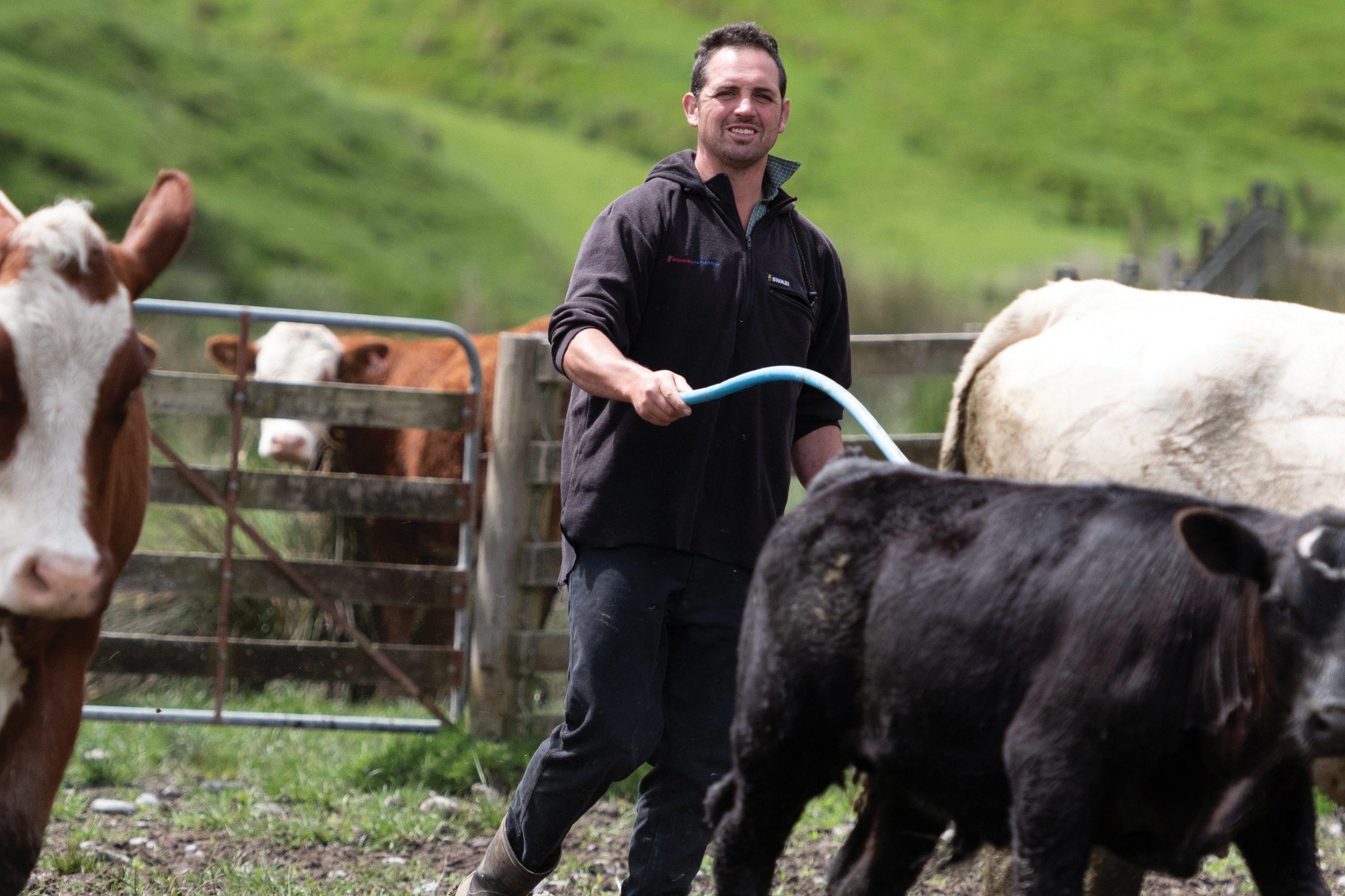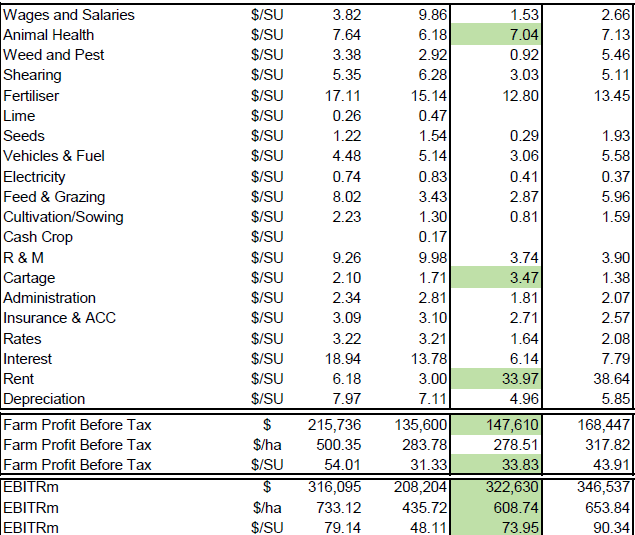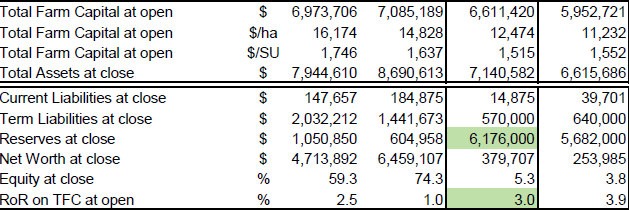Leasing for farm ownership
A Hunterville couple is moving closer to their goal of farm ownership by building equity through leasing and cutting costs, Terry Brosnahan writes.

A Hunterville couple is moving closer to their goal of farm ownership by building equity through leasing and cutting costs, Terry Brosnahan writes.
Pete and Erica Fitz-Herbert lease Pete’s father Bill’s 542-hectare hill country farm, which is in two blocks, 259ha (where Pete and Erica live) and the 283ha original home block (where Bill lives) seven kilometres apart at Upper Pakihikura.
Pete and Erica appeared in Country-Wide June, 2016 when they were leasing 263ha of Dad’s farm. Their son Harry was eight months old, now seven years old, and they were running 90 beef cows, 900 ewes and 60 stud ewes.
Six years on Pete, 37, and Erica, 33, have another child Ridge, 5, more land and were finally married in April this year. According to Erica, Pete was dragging the chain.
Both work on the farm, about one-a-half labour units, running 2000 Romney-Coopworth-Texel cross ewes and 500 hoggets. They also have 90 Dorset Down stud ewes that go over older ewes as terminal sires. They sell 35 rams a year. The Dorset Down is too heavy for the hoggets and they have tried other breeds. This year the couple are using some Wiltshire-Texel composites from Richard Morrison.
The Fitz-Herberts are part of a national farm survey run by Beef + Lamb NZ’s economic service. They are in Class 4, North Island hill country farms, Manawatu and Taranaki.
Gross farm revenue for 2020-2021 was $548,766 compared to the previous year’s $604,895. Total expenditure was $401,00 compared to $436,000 in 2019-2020. Rounded off, the earnings before interest, tax, rent, and manager wage (EBITRm) was $323,000 ($347,000) and the economic farm surplus (EFS) was $200,000 (231,000).
Quintile five (Q5) is the top 20% of farmers sampled, ranked by the EBITRm. The Q5 EBITRm in 2020-2021 was $316,000 and EFS, $173,000. The group mean was $208,000 and $70,000.
Pete and Erica try not to sell lambs store and in 2020-2021 sold about 80% prime, the mean for the survey, and they produced 89kg of lamb meat/ha, 10kg/ha more than the previous year. Total meat production was 180kg/ha (169kg, 2019-2020), which also included mutton, 28kg/ha and 63kg/ha of beef.
Their equity was 5.3% (3.8%). The EBITRm was 3% (3.9), well above the mean of 1%.
No surprises that their shearing expenses at $3/ssu ($5) was half the mean and the lowest recorded in the survey. The wool income was $7/ssu ($10).
This year there were 220 cows at the beginning of calving, 175 cows and 45 heifers – first-calvers. They run a three-way cross with a Charolais bull going over the Simmental-Shorthorn cows. This year calves from them weaned 330kg liveweight, while the Simmental-Shorthorn cross weighed 287kg LW. The Simmental and Shorthorn bulls are kept at Bill’s.
Pete says Bill will never retire. “He’s seen too many farmers retire to town then die.”
Bill has 142ha block near Waituna West, closer to Feilding, which Pete’s brother Tim, a property developer, is likely to farm part-time.
Pete is still single-sire mating for three cycles and swapping the bulls around.
They keep a close watch for “broken” bulls. The day Country-Wide arrived they found one.
“We were watching him ride and realised it wasn’t working,” Pete says.
Another bull was trucked in. There were already two yearlings covering a bull that had replaced another that had died.
Last year only 43 out of 50 first-calvers were in calf, which could be put down to a bull breaking down with a crook hoof.
The calving rate is usually 92% with the first-calvers calving in mid-July and the cows early August.

Extra time and effort pays off
Pete loves yard weaning. He says everytime a calf walks through a gate it’s led by its mother. Yard weaning teaches the calf to make its own decision. The weaned calves are held in holding paddocks and each day moved through the yards, along the race, in and out of the crush. Balage and hay are fed in the yards. By the third day the calves run over to the feeder.
It means more work but Pete enjoys the process and handling them. He does about 50 at a time, twice a day.
They sell 100 bull calves to Bill, along with most of the females that are not retained for breeding. Some are sold at the saleyards. Two Charolais bulls were kept over winter as back up and another three were sold to a dairy farmer.
Pete’s goal is to get everything gone by the second winter.
This year Bill had started killing in early January and the cattle weighed about 340kg carcaseweight (CW).
Lamb drafting usually starts late November and weaning early December, but this year it was January.
All the stock are killed through AFFCO because loyalty gains killing space, which for Pete is worth its weight in gold.
“The best premium I have is getting space.”
This season they sent away 100 lambs in November, which was three weeks earlier than they normally would. They went down to 35kg liveweight (LW) and averaged 17kg CW.

 They usually average 18kg CW over a season but with doom and gloom about the market they decided to take the money.
They usually average 18kg CW over a season but with doom and gloom about the market they decided to take the money.
“I’m always trying to get as many as I can away, straight off mum.”
Another 200 lambs went in early January.
Pete says they are sticking to the original plan of adding maternal genetics into the cattle herd. The Simmentals were too big and rangy for the hill country farm which gets wet and muddy.
The two blocks range from 250–518m above sea level. The farm is summer safe with rainfall of about 1000mm.
The Shorthorn has been added, to get a more compact cow that also milks well.
In five years time they expect to have the predominant red colour of the Shorthorn cross through the herd.
Another goal is to increase the number of polled cattle and it’s already about 90%. Pete buys only polled Simmental bulls but hasn’t been able to afford homozygous ones. Homozygous polled bulls crossed with unpolled cows won’t result in horned offspring. Some of the Shorthorn bulls were polled.
Shearing his own sheep
Farming wise, the biggest change for Pete is being his own boss. He has shorn a lot more of their own sheep to control costs. It is six-month shearing to reduce cast ewes and animal health costs.
Shearing contractors will shear the ewes at the 283ha block, but Pete does the winter shearing there and all the sheep at their block.
“If I’ve got a rousie I can do 40/run without hurting myself.”
The other day he did 55 ewes in a run. Perhaps he is getting more efficient as he gets older?
“I was a puddle of sweat but it was bloody good.” Usually he does a 100/day because there is always something else to do.
He shears about 50 lambs/run and in the past three years has shorn 5000 sheep a year. In future the boys will be able to help Erica in the woolshed.
Though they all might become redundant in the future as Pete bought a couple of Kaahu White shedding rams, Wiltshire and Australian White cross. He made the decision while shearing.“It was Christmas Eve and everyone was off on holiday and I thought maybe there is a better way.”
The shedding sheep are also a way to combat the threat of drench resistance. The couple haven’t rushed in and bought 300 or 400 Wiltshire ewes to change overnight. Instead they have taken the cheaper and longer route. They will have a small, tagged flock to see if the shedding sheep will fit the farming system and handle the environment. “If their feet fell apart it would be an expensive mistake.”
Pete tagged 60–70 ewe lambs after using a shedding-type ram last year and the males weighed satisfactorily.
The lambing beat has become less intensive in the past six years. If Pete is going around hoggets the focus is on saving a hogget more than a lamb. He stills goes around the mixed-aged twice a day and will put a bearing back in. Singles only get looked at once a day and the lambing beat works in with feeding the cows.
With the boys at school, Erica has more time to help out with the lambing beat.
The hoggets started lambing September 15 and they tailed 380 lambs out of 500 mated.
“It wasn’t the best weather at the time.”
The early ewes start lambing about August 6 or 7, and the main line, August 20. This year, average lambing across the whole flock was 146%.
Feeding out hay to cows is a cost of calving earlier. About 3000 small, conventional bales of meadow hay are made for feeding out on the hills with a quad bike in winter, rather than large bales. “Winter is too dangerous for feeding out on the hills with a tractor,” Pete says.
They don’t grow any feed crops. They grew kale about four years ago but it was too muddy.
They use dams for stock water. A system using a solar pump is all set up ready to take water out of a spring and gravity feed it to troughs. Pete is just waiting for a part to get it working.
Stopping fertiliser
The soils are sulphur and selenium deficient so on one block an annual dressing of 185kg/ha Maxi super 15 (15k, 7.4S and 6.7P) goes on in the autumn. Selenium is added to the fertiliser.
For the last two years a dicalcium phosphate fertiliser has been going on the 259ha block and they’ll follow up this year with soil testing.
Pete says the Olsen P is 25–30 and the pH 5.8–6, but a big amount of lime goes on every 10 years. Using a dicalcium may avoid having to do that and still get similar results.
He is thinking about withholding the fertiliser for a year and putting the $50,000 elsewhere.
Soil scientist Dr Doug Edmeades of agKnowledge says if the Olsen P levels are in the range 20–25, then based on science, the Olsen P will decline at about 1–2 units a year. This will have no observable effect on production in year one.
Edmeades says it is a sensible strategy to withhold fertiliser for a year and redirect the funds to other more urgent tasks. This may include economic survival or correcting other nutrient limitations especially potassium.
“Remember the plant can only grow at the rate determined by the most limiting nutrients.”
Edmeades says if the economic optimal was 20 and the Olsen P 30 then a farmer could have 5-10 years of P in the bank assuming that the Olsen P will decline at 1-2 units a year.
This year (2022-2023) is the first time in six years that Erica and Pete haven’t put capsules in the ewes, because they started finding resistance. “Most ewes got through a bit skinner and the lambs a little bit lighter.” They are testing more after a lamb drench. The first drench is late October and between drenches are being stretched out to more than a month. Ewes are given a five-in-one pre-lambing.
The Fitz-Herbert family is working on farm succession, which will probably involve the couple leasing off a trust structure.
There are always farm jobs to do even on the weekends and more work with more than one block, so the couple want to adjust their system so they can spend more time with children.
“I keep telling people sheep farming is a form of child neglect at times,” Pete says.
So Erica and Pete are developing more off-farm goals.
At some stage the couple’s plan is to own a farm. The lease in 2020-2021 was $280/ha.
Pete says about three years ago leasing offered an opportunity to own a farm. With the rise in land values, it would be difficult.
“The opportunity to do it on your own without family has totally disappeared.”
For Pete and Erica leasing has been a good way to build equity, but they’ve had to put the work in.
- To read the Country-Wide June, 2016 article on the Fitz-Herberts head to: bit.ly/3IZPiXg




